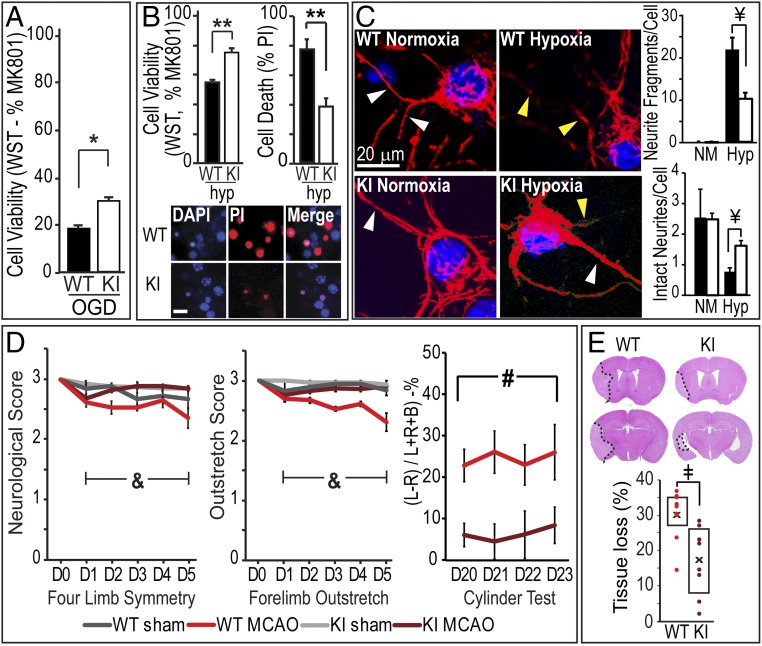Fig. 1.
The UCHL1 C152A mutation attenuates hypoxia/ischemia-induced neuronal injury and improves behavioral outcome. (A and B) In vitro cell viability and cell death in WT and mutant UCHL1 C152A (KI) primary neuronal culture after OGD (A) and hypoxia (B). (A) Cell viability based on WST-1 assay with MK801 (MK) as 100% survival control and staurosporine (SP; 30 μM) as 100% cell death control 24 h after 15 min OGD. Data are expressed as percent MK (n = 12 wells per group). (B, Upper Left) Cell viability 24 h after 3.5 h hypoxia based on WST-1 assay (n = 18 wells per group). (B, Upper Right) Cell death as measured by percent PI (red) or DAPI (blue) staining (n = 10 wells per group). (Scale bar: 20 μm.) (C) Effects of the C152A mutation on hypoxia-induced neurite damage. Primary neurons from WT or KI mice underwent 2.5 h hypoxia (Hyp) or normoxia (NM) treatment followed by immunohistochemical staining with anti-neurofilament (red) antibody. (Left) Representative confocal images. Yellow arrows indicate neurite fragments; white arrows are intact neurites. (Right) Fragment and intact neurite analysis 24 h post hypoxia (n = 8–15 fields per group). Blue indicates DAPI nuclear stain. (D) The UCHL1 C152A mutation attenuates behavioral deficits after 60 min MCAO. (Left and Center) Four-limb symmetry and forelimb outstretch scores on days 1–5 post ischemia. (Right) Cylinder test scores at days 20–23 post injury (L, ipsilateral; R, contralateral; B, both). (E) Whole-brain tissue loss in WT and KI mice 21 d post injury. (Upper) Representative H&E-stained slices. Dotted line indicates and infarct border. (D and E) n = 8–10 per group. Data are means ± SEM (*P < 0.05 and **P < 0.01, independent-samples t test; ¥P < 0.001, two-way ANOVA with Tamhane’s T2 post hoc test; &P < 0.001, two-way repeated-measures ANOVA with Bonferroni post hoc test; #P < 0.05, ANOVA; ‡P < 0.01, Mann–Whitney U test). Black/gray bars indicate WT; white bars indicate KI.

